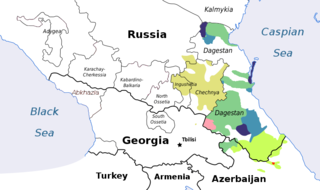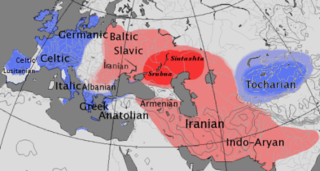Velars are consonants articulated with the back part of the tongue against the soft palate, the back part of the roof of the mouth.

The Northwest Caucasian languages, also called West Caucasian, Abkhazo-Adyghean, Abkhazo-Circassian, Circassic, or sometimes Pontic languages, is a family of languages spoken in the northwestern Caucasus region, chiefly in three Russian republics, the disputed territory of Abkhazia, Georgia, and Turkey, with smaller communities scattered throughout the Middle East.

The Northeast Caucasian languages, also called East Caucasian, Nakh-Daghestani or Vainakh-Daghestani, or sometimes Caspian languages, is a family of languages spoken in the Russian republics of Dagestan, Chechnya and Ingushetia and in Northern Azerbaijan as well as in Georgia and diaspora populations in Western Europe and the Middle East. According to Glottolog, there are currently 36 Nakh-Dagestanian languages.
Uvulars are consonants articulated with the back of the tongue against or near the uvula, that is, further back in the mouth than velar consonants. Uvulars may be stops, fricatives, nasals, trills, or approximants, though the IPA does not provide a separate symbol for the approximant, and the symbol for the voiced fricative is used instead. Uvular affricates can certainly be made but are rare: they occur in some southern High-German dialects, as well as in a few African and Native American languages. Uvular consonants are typically incompatible with advanced tongue root, and they often cause retraction of neighboring vowels.

Abkhaz, also known as Abkhazian, is a Northwest Caucasian language most closely related to Abaza. It is spoken mostly by the Abkhaz people. It is one of the official languages of Abkhazia, where around 100,000 people speak it. Furthermore, it is spoken by thousands of members of the Abkhazian diaspora in Turkey, Georgia's autonomous republic of Adjara, Syria, Jordan, and several Western countries. 27 October is the day of the Abkhazian language in Georgia.
Pontic is a proposed language family or macrofamily, comprising the Indo-European and Northwest Caucasian language families, with Proto-Pontic being its reconstructed proto-language.
Abaza is a Northwest Caucasian language spoken by Abazins in Russia. The language has gone through several different orthographies based primarily on Latin and Cyrillic letters. Its consonant-to-vowel ratio is remarkably high; making it quite similar to many other languages from the same parent chain. The language evolved in popularity in the mid to late 1800s, but has become an endangered language.

Pharyngealization is a secondary articulation of consonants or vowels by which the pharynx or epiglottis is constricted during the articulation of the sound.
Labialization is a secondary articulatory feature of sounds in some languages. Labialized sounds involve the lips while the remainder of the oral cavity produces another sound. The term is normally restricted to consonants. When vowels involve the lips, they are called rounded.

The North Caucasian languages, sometimes called simply Caucasic, is a proposed language family consisting of a pair of well established language families spoken in the Caucasus, predominantly in the north, consisting of the Northwest Caucasian family and the Northeast Caucasian family. There are some 34 to 38 distinct North Caucasian languages.
In phonetics, ejective consonants are usually voiceless consonants that are pronounced with a glottalic egressive airstream. In the phonology of a particular language, ejectives may contrast with aspirated, voiced and tenuis consonants. Some languages have glottalized sonorants with creaky voice that pattern with ejectives phonologically, and other languages have ejectives that pattern with implosives, which has led to phonologists positing a phonological class of glottalic consonants, which includes ejectives.

The uvular ejective is a type of consonantal sound, used in some spoken languages. The symbol in the International Phonetic Alphabet that represents this sound is ⟨qʼ⟩.

The voiced uvular plosive or stop is a type of consonantal sound, used in some spoken languages. The symbol in the International Phonetic Alphabet that represents this sound is ⟨ɢ⟩, a small capital version of the Latin letter g, and the equivalent X-SAMPA symbol is G\.
Abkhaz is a language of the Northwest Caucasian family which, like the other Northwest Caucasian languages, is very rich in consonants. Abkhaz has a large consonantal inventory that contrasts 58 consonants in the literary Abzhywa dialect, coupled with just two phonemic vowels.
Proto-Circassian is the reconstructed common ancestor of the Adyghean and Kabardian languages.
The Cyrillic script family contains many specially treated two-letter combinations, or digraphs, but few of these are used in Slavic languages. In a few alphabets, trigraphs and even the occasional tetragraph or pentagraph are used.

Languages of the Indo-European family are classified as either centum languages or satem languages according to how the dorsal consonants of the reconstructed Proto-Indo-European language (PIE) developed. An example of the different developments is provided by the words for "hundred" found in the early attested Indo-European languages. In centum languages, they typically began with a sound, but in satem languages, they often began with.
This article discusses the phonology of the Inuit languages. Unless otherwise noted, statements refer to Inuktitut dialects of Canada.
Proto-Northwest Caucasian, also Proto-Adyghe-Abazgi or Proto-Adyghe-Abkhaz, is the reconstructed common ancestor of the Northwest Caucasian languages.
Adyghe is a language of the Northwest Caucasian family which, like the other Northwest Caucasian languages, is very rich in consonants, featuring many labialized and ejective consonants. Adyghe is phonologically more complex than Kabardian, having the retroflex consonants and their labialized forms.







